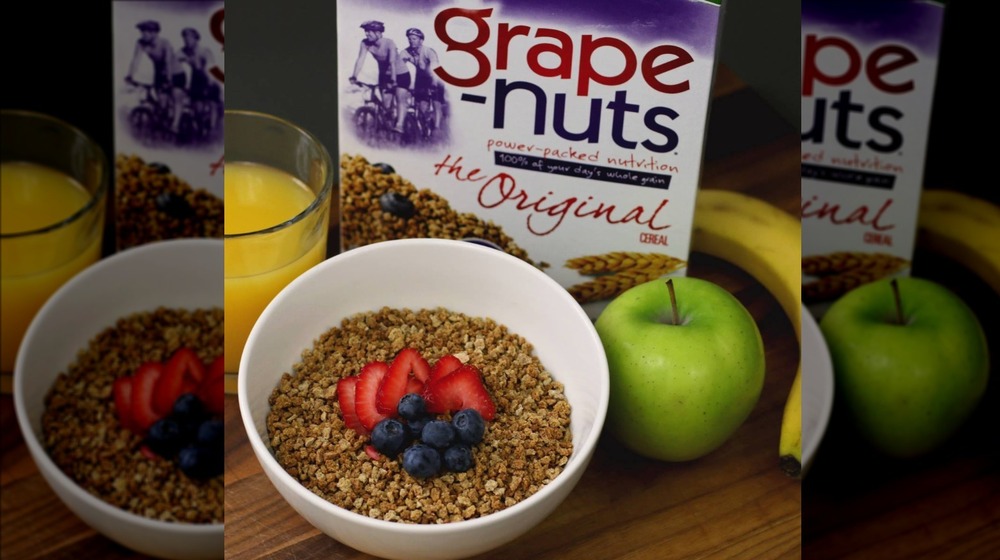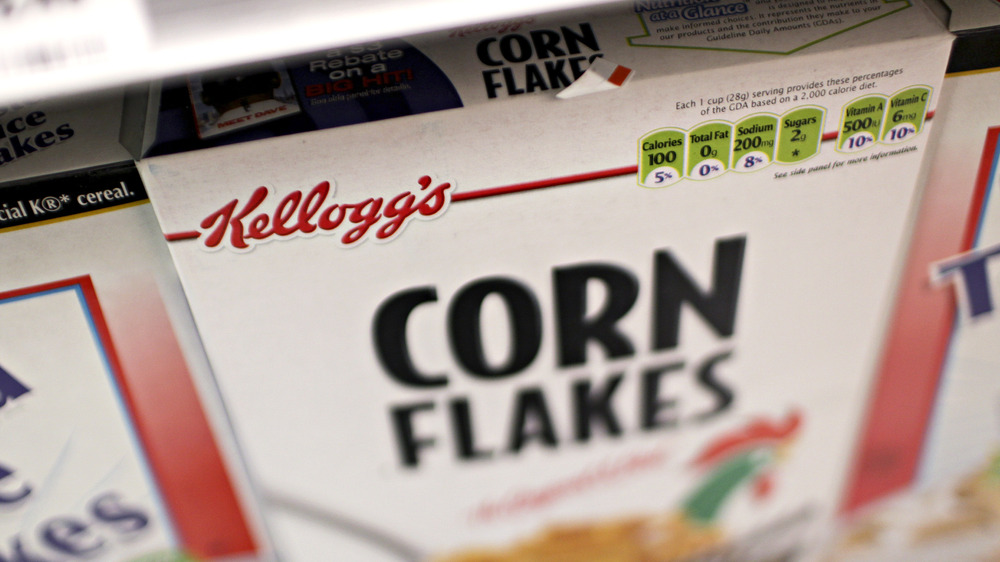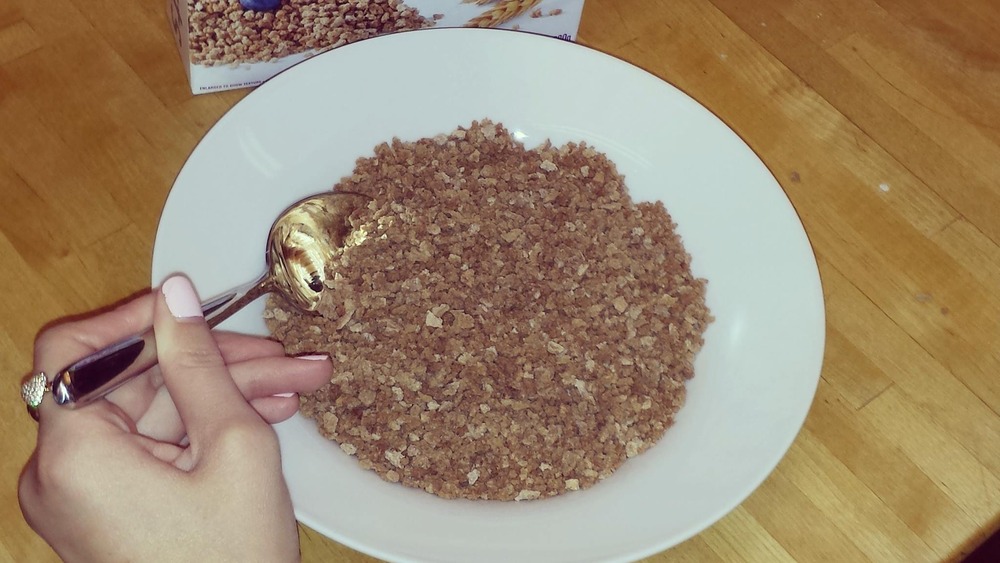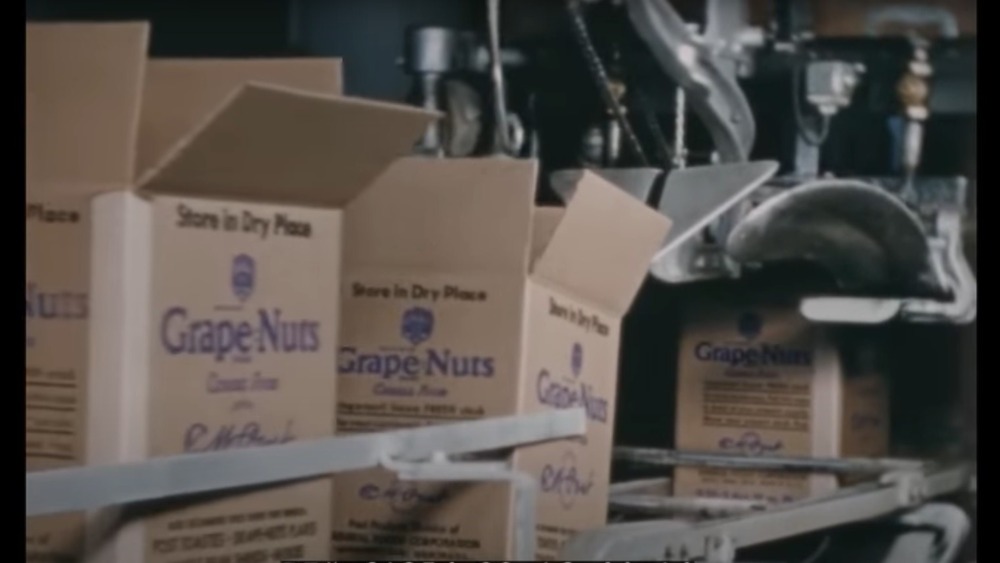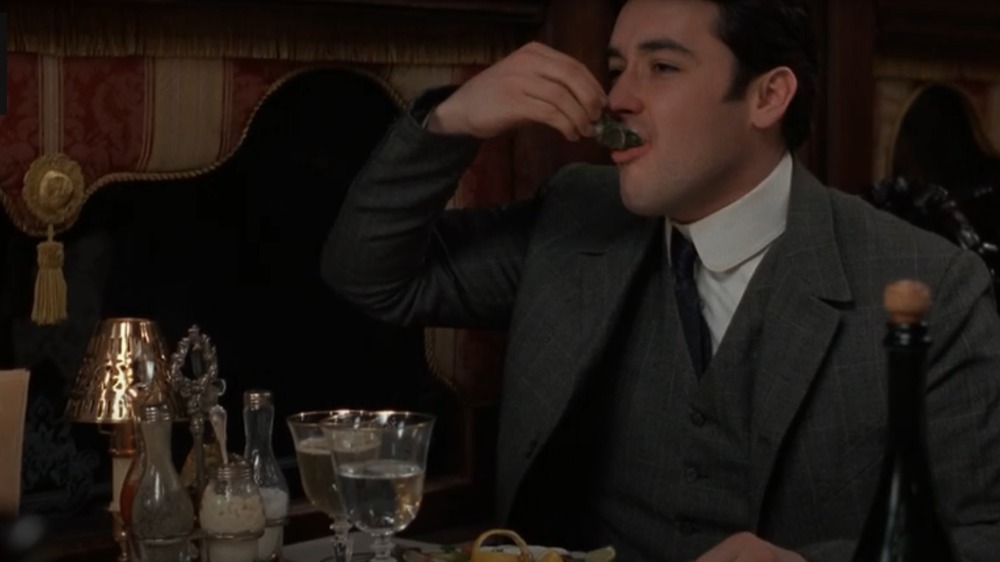The Untold Truth Of Grape-Nuts
Grape-Nuts was one of the first cereals that Americans began to stock in their kitchen shelves. Introduced as a medicine food in 1897, it made it through the Great Depression of the 1930s, two World Wars, and the Covid'19 pandemic that saw a halt in its production for a while (via New York Historical Society). The pandemic unveiled the many true fans of the cereal who were ready to pay more than thrice the amount to bring home a little box of the tasty nuggets.
To understand how Grape-Nuts became a breakfast constant is to understand the history of cereal itself. It all started with the invention of Granula — a cold cereal made with Graham flour — by doctor James Caleb Jackson in 1863 (via Smithsonian Magazine). Jackson never earned any success with Granula, but he paved the way for food innovators, such as CW Post, to create their own kind of cereal.
Post created Grape-Nuts in a small factory in Battle Creek, Michigan and saw a huge success. It was "an accomplishment that inspired dozens of imitators and turned Battle Creek into the cereal-making capital of the United States." In less than five years, there were around 100 cereal manufacturers in Battle Creek alone.
The cereal gave Americans a taste of a meat-less, caffeine-free, cold and convenient breakfast. Here's how the crumbly and malty cereal has sustained itself for over 120 years.
Kellogg's had a role to play in the invention of Grape-Nuts
CW Post had a busy life even before Grape-Nuts. Though a University of Illinois drop-out, Post was always an innovator at heart. He held patents for farm equipment, including "cultivators, a sulky plow, a harrow, and a haystack." Unfortunately, Post didn't handle stress well. He had a nervous breakdown twice, before he sought treatment in one of the most popular health spas of the world then, Battle Creek Sanitarium in Michigan. This sanitarium was run by Dr. John Harvey Kellogg — the same Kellogg who gave the world cornflakes.
Kellogg and his brother WK Kellogg were into experimenting with dishes that would best maintain the gut health of the patients who were admitted in the sanitarium. During his stay there, Post was served and exposed to the making of Kellogg's invention, Granola — a mixture of corn meal and oats. Kellogg, a deeply religious Seventh-day Adventist, believed that eating something bland and easily digestible was the cure to many forms of illnesses. He also believed in a diet sans alcohol, coffee or meat. Looks like people took to his methods, for among his clients were personalities like as Thomas Edison and Henry Ford.
Post wanted to sell the cereal he was served in the sanitarium to people in the outside world Having learnt the ways from the Kellogg brothers, he invented a cereal-based drink called Postum as an alternative to coffee. Grape-Nuts cereal was his second product. (via History)
Grape-Nuts contains no grapes or nuts
The name Grape-Nuts can be quite misleading. The cereal doesn't contain a single grape or nut; it's made with only wheat and barley. Originally, according to Grape-Nuts' official website, the ingredients were mixed and poured into a sheet, and baked in the oven. Once hard, it was broken into large chunks, and then into smaller "nut-sized nuggets" using a coffee grinder.
These nuggets, to Post, looked like grape seeds — hence the name, says one theory. Another says he named the product so because of a certain nutty flavor that it left in the mouth. The word grape came from "grape sugar," which is what Post called glucose. He believed that when the batter containing the carb-heavy mix was baked, it produced glucose.
Grape-Nuts was first introduced as an alternative to morning coffee. As the story goes, when he was recuperating from a nervous breakdown in Battle Creek Sanitarium, he particularly liked a cereal-based caramel drink that was served there. However, Post could not get the permission from Dr. John Harvey Kellogg, the man who ran the show at the sanitarium, to sell the beverage. So, with the help of a Swiss chemist, he designed a beverage called Postum instead. Grape-Nuts was also at first introduced it as an alternative to morning coffee, but it only found success when he changed the advertising words to call itself "cold breakfast food".
Grape-Nuts was first introduced as a health product
CW Post advertised Grape-Nuts as a "food for brain and nerve centers," — even claiming that it could cure appendicitis and keep the body temperature in control!
According to a booklet published by Postum Company in 1906, "anyone with weak intestinal digestion, liver and bowel troubles can correct them without drugs, by leaving off the bread, cakes, mushy cereals, potatoes, and all forms of starchy food, and using Grape-Nuts." Post claimed that Grape-Nuts was a "pre-digested" food, claiming that the wheat and barley mix is processed in such a way that it converts starch to sugar outside of the stomach, leaving little work for the digestive system. He further claimed that it was absorbed well by the body, and "has double the energy producing power of any other food on earth," the book claimed.
Post relied heavily on showcasing Grape-Nuts as a healing food, and posted several ads to convey the point. All these were let pass until 1911, when a certain publication expressed its concerns about these claims. Collier's Weekly "published an editorial stating (quite correctly) that the implication that Grape-Nuts could ward off appendicitis was not only false, but potentially deadly" (via Scalar). In response, Post started a campaign defaming the publication.
The case went to court, and it came to be known that Post had solicited all the testimonials from customers claiming Grape-Nuts had healed them. The legal saga ended with Post handing over $50,000 to the publication.
Grape-Nuts was the first to introduce grocery coupons in 1909
CW Post knew how to sell his product. He was the one of the first to sell packaged cereal in boxes and spent about one million dollars a year on advertisements, even back in 1906. When Grape-Nuts hit the market, the concept of cold breakfast food was something that Americans were only warming up to. Post went the extra mile to spread the word through recipe contests and coupons. He was also the first to introduce coupons in grocery shopping, giving away one-cent coupons that customers could redeem on their purchase of a Grape-Nuts box.
Only one other company had experimented with the this novel idea before Post did: Coca-Cola. The black syrup that was introduced by John Pemberton in a pharmacy in 1886 saw scanty sales until Asa Candler, a druggist, started giving free vouchers for the drink through magazines and newspapers (via Wired). Like Candler, Post also succeeded in making his product popular with the masses by giving them the opportunity to save on their purchases.
After Post started giving away coupons in 1909, the concept became popular in the United States, especially during and post the Great Depression in the 1930s. Today, shoppers save 10% to 20% on grocery shopping with just the coupons (now also available digitally), according to Chicago Tribune – all thanks to Post's one-cent idea.
The plant where Grape-Nuts was first manufactured is still functional
Grape-Nuts had its beginnings in a small white barn in Battle Creek, Michigan. CW Post started using the space for developing Postum and Grape-Nuts in 1895; slowly, several new buildings mushroomed around it to handle the capacity of food production. Today, the plant includes 40 buildings that span "over 65 acres with a nearly 2 million-square-foot facility," according to Ty Hakman, manager at the Battle Creek plant (via WBCK). The plant manufactures Post Consumer Brands' products including Grape-Nuts, Honey Bunches of Oats and Fruity Pebbles, among others.
The Battle Creek plant of Postum Cereal Company was the largest in the world in the early 1900s, "with 2,500 employees and a net worth of $5 million," Encyclopedia reports. Today, it employs 600 people, some of whom were third and fourth-generation employees, Hakman told WBCK.
Though the Battle Creek Plant has been functioning for 125 years, at one point, Grape-Nuts was only being manufactured at a plant in Modesta, California. Wall Street Journal reported that "In 2005, four Grape-Nuts ovens in Battle Creek were scrapped, leaving just the one here in California." The Modesto plant had to be shut down in 2013 because of a decrease in cereal demand. But the pandemic seems to have perked up the cereal industry. "We put out, this year alone, over 280 million pounds of product," Hakman told WBCK.
Grape-Nuts also inspired its own ice cream flavor
Grape-Nuts ice cream has for years kept its place as a sought-after dessert in New England, most especially in Maine, according to Eater. The recipe for this cereal-rich ice cream is over a century old. Some say that it was a certain chef named Hannah Young in Nova Scotia, Canada, who invented it in 1919 (Young used Grape-Nuts cereal as an alternative to fresh fruits in her ice cream and realized that it makes for a tasty dessert). However, there are mentions of the recipe in publications that pre-date Young's claim, according to author and food historian Sarah Wassberg Johnson.
For example, The American Housekeeper Advertiser published a recipe for Grape-Nuts ice cream in its 1909 issue, and so did Good Things to Eat from Wellville, which was published in 1916. The ice cream can be made in two ways: The longer method requires heating Grape-Nuts cereal with cream and sugar and adding almond and vanilla extract to the mix when it's cool, followed by freezing it until it reaches the consistency of an ice cream. The shorter method includes mixing vanilla ice cream with the desired amount of Grape-Nuts into it. Either way, a little bit of crunch can elevate your simply vanilla.
The parent company of Grape-Nuts was renamed General Foods in 1929
CW Post's breakfast food innovations were a huge success, including both Grape-Nuts or Post Toasties (a brand of corn flakes). After establishing Postum Cereal Company, Post moved from Michigan to Texas with the dream of starting a farming community. While there he explored different ways of dry-land farming, and experimented with making rain through dynamite explosions. Meanwhile, Postum Cereal Company reaped profits. By 1900, Post was netting $3 million a year. But the success wasn't enough to keep him in the pink of health — he is believed to have died because of a self-inflicted gunshot in 1914. (via Texas State Historical Association)
After Post's death, the company went to his daughter Marjorie Merriweather Post, who, along with her husband and company chairman Edward F Hutton, began a series of acquisitions that included Jell-O, Swans Down cake flour, Minute Tapioca, Baker's Chocolate, Log Cabin syrup, and Maxwell House Coffee (via Encyclopedia).
Postum Cereal company eventually became General Foods in 1929, after it acquired Clarence Birdseye's General Foods Company. Birdseye is said to have revolutionized the modern frozen industry, and Post and her husband brought him in as the head of the General Foods Laboratory. From 1929 onwards, Grape-Nuts was a product manufactured by General Foods. After Philip Morris Companies acquired General Foods in 1985, the corporate leadership manning the production of Grape-Nuts changed several hands before finally taking form as Post Consumer Brands.
Grape-Nuts was an important food item for American soldiers in World War II
Grape-Nuts kept US soldiers from starving during World War II, according to company lore. According to Grape-Nuts' official website, the cereal was part of the jungle ration provided to the soldiers who were stationed in tropical countries. Back then, cereal was a more functional food — and taste mattered little. In fact, Grape-Nuts was not coated with sugar until the 1940s, and it was a mix of baked and ground wheat and barley that claimed to go easy on your digestive tract. The fact that it didn't have to be cooked was a bonus. But what made the cereal synonymous with breakfast was a certain ad campaign by General Foods (which manufactured Grape-Nuts then) in 1944.
As part of the campaign, the company channeled money and time into conveying to the masses that "nutrition experts say breakfast is the most important meal of the day." (via The Atlantic). While studies have shown little to validate the statement, the brands did succeed in convincing customers that cereal is the best way to start their day. Soon the government nutritionists were also sold to the idea, and "in the interest of improving the health of army recruits, they teamed up with cereal companies to suggest that everyone eat a "good breakfast of whole-grain cereal and fruit."
Grape-Nuts was the first cereal to reach the top of Mount Everest
New Zealand explorer Edmund Hillary and Nepali-Indian Sherpa explorer Tenzing Norgay ventured on the 29,000 feet climb to the peak of Mount Everest with Grape-Nuts cereal in their backpack. Post Grape-Nuts cashed in on this little trivia by launching a campaign called "What's your Mountain?" in 2013. As part of the promotion, the brand introduced a new variety of Grape-Nuts cereal called Grape-Nuts Fit, which came with the addition of cranberries, granola, puffed barley, among other ingredients. The company also collaborated with "tower racers," or athletes who race up the stairs of skyscrapers (via Consumer Goods).
Besides conquering the tallest mountain in the world, Grape-Nuts was also the favored snack in expeditions to the North and South Pole. In 1913, Donald B. Macmillan had taken Grape-Nuts cereal to munch on during his two-year expedition to Crocker Island in the Arctic. Later, in 1933, Grape-Nuts sponsored the expedition of Sir Admiral Byrd to Antarctica. While this was a boost to Post Company's marketing, it also served as a big moment for science because it enabled the first "long two-way radio transmission" (via Grape-Nuts' website).
The Andy Griffith show exists because of Grape-Nuts
Back in the 1950s, General Foods, which owned Grape-Nuts then, used to sponsor a show called The Danny Thomas Show. But they disassociated themselves with the show as it "depicted a discordant, urban family life" that did not do well with the brand's "wholesome family image" (via Grape-Nuts' official website). A certain character in the show, Sheriff Andy Taylor, featured as someone who held justice in the highest regard and was loved by all in the fictional town of Mayberry, North Carolina, became so popular that he warranted his own series. Thus was launched The Andy Griffith Show that ran for eight years but continued to air on television for over 50 years. (via The Atlantic)
Since General Foods sponsored the show, commercials promoting its product Grape-Nuts cereal were infused during the breaks, and they starred Sheriff Andy Taylor and Deputy Barney Fife — the two main characters of the series, who promoted the tagline "A Grape-Nuts breakfast fills you up, not out".
In the decades that followed, Grape-Nuts' promotional campaign took a different form. The brand roped in Euell Gibbons, who is considered the father of modern foraging, to be part of Grape-Nuts' Back to Nature campaign. Little did Gibbons know that his line for the ad, "Ever eat a pine tree? Many parts are edible" would be discussed even decades after he used it.
A Grape-Nuts booklet inspired the movie The Road to Wellville
The Road to Wellville was a thin insert inside the Grape-Nuts boxes in the early 1900s, until it inspired TC Boyle to write a novel of the same name. Boyle's novel, however, has no mention of CW Post or Grape-Nuts. What it focuses on, instead, is John Harvey Kellogg and his Battle Creek Sanitarium in Michigan, where Post was treated in the late 1800s. The novel was adapted into a movie directed by Alan Parker and starred big names such as Anthony Hopkins, John Cusack, and Bridget Fonda (via Battle Creek Enquirer).
The movie, which is a satiric take on the personality of Kellogg (who invented peanut butter and meat substitutes, besides granola) and his uncommon methods of treatments at Battle Creek sanitarium, disappointed the Battle Creek localities. They took pride in the fact that their community once welcomed the who's who of the world to a wellness spa that was considered one of the best in the country in its heydey; but the movie, filled with sexual content and jokes, had little to do with the facts.
There was a shortage of Grape-Nuts during the pandemic
When the pandemic struck in 2020, the demand for cereals saw an uptick, given many people had little choice but to stay home. Post Consumer Brands, the company that manufactures Grape-Nuts, found it challenging to meet this sudden spike in demand, and the production had to be stopped due to supply chain constraints. "Grape-Nuts is made using a proprietary technology and a production process that isn't easily replicated, which has made it more difficult to shift production to meet demand during this time," Kristin DeRock, Grape-Nuts brand manager at Post Consumer Brands, told TODAY.
Grape-Nuts fans felt the panic when they couldn't access their box of cereal, which is usually a staple in the supermarkets. Customers, including producer David Heyman, took to social media to express their concern about the sudden Grape-Nuts cereal shortage. "I am among those suffering from the great #grapenuts shortage. May their return bring a little comfort in troubled times," tweeted Heyman. With limited boxes in circulation, the price of a 29 ounce box, originally $4.99, became three times more. "On Walmart.com, a 64 ounce box was listed for $110," The New York Times reported.
Grape-Nuts boxes are all stocked up in supermarkets now, but the brand hasn't forgotten their loyalists. To all those who shelled out more than $10 a box, Post Consumer Brands announced that they will reimburse them upto $115 upon receiving the receipt of purchase.
